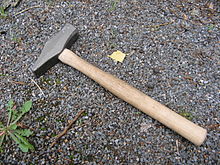Blacksmith hammer
A forging hammer is a hammer used in the blacksmith 's trade .
Hammers are divided into three basic types: the single-handed to be used hand hammers kg with a head mass of one to two, the two hands to be used supplement hammers ( Vorschlag- or cross hammers kg) having a head mass of 3 to 15 and the auxiliary hammers .
Depending on the task at hand, there are different forms of hammer track on hand or hammer hammers , from smooth tracks with only slightly broken edges on flat hammers to forging flat, smooth surfaces, over the widespread only slightly curved track and the heavily curved track used for forging curves Path of the ball hammer up to the spherical path of the driving hammer used in driving or lead work or forging tasks .
The group of auxiliary hammers is extremely comprehensive, so there is, for example, shot peening with sharpened fin for cutting metal, hole hammers for producing round, oval or rectangular holes, Schlicht hammers with a flat, square web for finishing of surfaces or Falzhämmer with a slightly curved and rounded cutting edge for working in the fold in the horseshoe, for example.
The auxiliary hammers are not hit directly on the workpiece, but are positioned by the forge on the forging at the relevant point and hit by the hammer with a hammer head by hitting the hammer head or driven into the material. To avoid impact damage, the stems of the auxiliary hammers are therefore only loosely in the hammer eye yuo.
The shape of the hand hammers has penetrated in general, that is, they are shorter for the same head mass and thicker than a peen hammer executed. Hand forged hammers often have a thickening around the eye so they can be even shorter. Since the forging hammer is only used to strike unhardened steel, the face and fin are not particularly hardened. As with all hammers , the middle part, the house , is exempted from hardening and therefore remains soft to prevent the hammer from bouncing. However, the Swedish shape of the blacksmith's hammer (hand hammer) is longer and slimmer.
See also
- Blacksmith
- Wrought
- Air hammer
- Tail hammer
- Drop hammer
- Spring drop hammer (spring hammer)
literature
- Hermann Hundeshagen: The blacksmith at the anvil. A practical textbook for all blacksmiths . [[Manuela Kinzel Verlag]], Göppingen 2019, ISBN 978-3-95544-120-3 , p. 28 ff.

